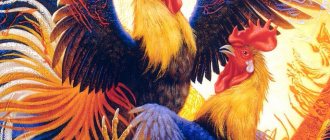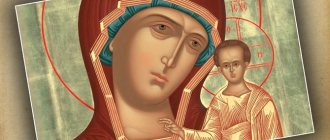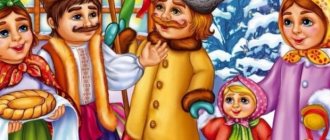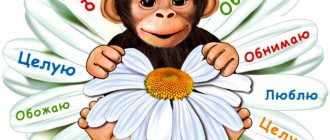History of the holiday. When is Maslenitsa in 2021
Maslenitsa was celebrated in ancient Rus'. Paganism reigned at that time, but the festivals even then meant the transition from winter to spring. The date of the event was fixed and was set on the day of the spring equinox. The festivities lasted for a week. Nature, land, and continuation of the family were glorified. In Rus', on this day they thanked the gods for a bountiful harvest. Now this tradition has been lost, but during the week of Maslenitsa they honored dead relatives.
Important! Maslenitsa is a pagan holiday. They praised the sun god and the god of cattle. Dozens of traditions, signs, and rituals were associated with the holiday week.
Now the festival has changed. It does not carry a sacred load. With the advent of Christianity, Maslenitsa week serves as the last stage before Lent. The date is floating and depends on Easter. In 2021, Maslenitsa will begin on March 8 and end on March 14.
The church consecrated the pagan holiday. Maslenitsa week was the last stage before Lent. People must forgive loved ones for insults, repent of sins, and reconcile with relatives. If during pagan times it was forbidden to eat meat during Maslenitsa week, now it is one of the most nourishing weeks of the year. The people called the holiday:
- overdrinking;
- killer whale;
- a hawk;
- overeating.
Ancestors also forbade marriage from the beginning of Maslenitsa until Easter. On Saturday, dinners were held in memory of the deceased, and on Sunday people went to visit and celebrated the arrival of spring. Maslenitsa served as a symbol of the unification of families, a time of reconciliation and forgiveness of grievances. It was also customary to thank loved ones.
History and traditions of celebrating Maslenitsa in Russia
Maslenitsa has long been a national holiday that did not have any age, social, family or gender restrictions. Non-participation in the holiday could be justified only by a person’s injury, weakness or illness. She was joyfully greeted by both the population of the rural outskirts and the residents of the capital, large provincial and small district towns of Russia.
We started preparing for Maslenitsa from the middle of the previous week. At this time, the housewives cleaned all corners of the house - from the attic to the cellar: they refinished the whitewash of the stoves, scraped tables, benches and floors, prepared holiday dishes for use, swept out garbage from the yard and in front of the gate. They bought a large number of products for the holiday: different types of flour for pancakes, baked goods and pies, salted fish, gingerbread cookies, sweets and nuts for children, collected milk, cream, sour cream and cow butter.
The Saturday before Maslenitsa was called “little Maslenitsa.” On this day it was customary to remember deceased parents. A special treat was baked for them - pancakes - and placed on the shrine, dormer window or roof, left on the graves in the cemetery, and distributed to the poor in churches.
Maslenitsa celebrations began on Monday of the following week. For the entire Russian population, the coming seven days were the most fun and favorite time of the year. Each of them had its own name: Monday - “meeting”; Tuesday – “flirts”; Wednesday – “gourmet”; Thursday - “revelry”, “turning point”, “wide Thursday”; Friday – “mother-in-law’s evening”; Saturday – “sister-in-law’s get-togethers”; Sunday - “seeing off”, “farewell”, “forgiveness”, “forgiveness day”.
The most important were the last four days of the holiday, called “broad” or “rambunctious Maslenitsa”. The day before they should have washed themselves in the bathhouse, “cleansing” themselves of the hardships and misfortunes of the past year. People stopped working in their homes all the time and started visiting relatives and friends.
On Maslenitsa, rich, hearty tables were set with flour and dairy foods, as well as eggs, fish dishes, pies, kvass, and beer. The festive meal necessarily included pancakes - a pagan symbol of the sun and an obligatory attribute of funerals.
These days, class, property, and official differences weakened. Unknown people, wanderers, and beggars could be invited to the table. Relatives visiting each other for pancakes brought them closer together and provided a convenient reason to forget the grievances and discontent that had accumulated over the year.
Maslenitsa was marked by the performance of a large number of rituals associated with honoring the “newlyweds” - young spouses who got married this year. They were rolled in the snow, rolled down the mountains on frozen animal skins and sleds, and placed on overturned harrows.
Everywhere, the main holiday activity was sliding down slides - on sleighs, pet skins, overturned benches, icy troughs and sieves. In the north and in the Volga villages, parallel poles were laid on elevated places during Maslenitsa week for young people to ride in pairs. Also, smartly dressed youth rode horses, moving from village to village with noise, songs and playing the harmonica. The horses were decorated with ribbons, flowers and ringing bells.
During Maslenitsa week, the game “Taking the Snow Town” was played in the Cossack settlements of Siberia, the Urals and the Krasnoyarsk Territory, as well as in the Simbirsk, Penza and Tula provinces. The tradition of building fortresses or towns from compacted snow has been known since the beginning of the 18th century. Initially, this entertainment was typical only for the service population, but later rural residents began to follow their example. The towns were built in open and accessible places - on the ice of rivers and lakes, in squares in large villages and cities.
On the last day of the week, Maslenitsa was celebrated in the provinces of Russia. In some areas the ritual took the form of burning a Maslenitsa effigy, in others - in the form of a funeral send-off.
In the northern, central and Volga provinces, Maslenitsa was burned on a special bonfire on the last day of the holiday.
The participants of the Maslenitsa train brought the symbol of the holiday or brought it impaled on a pole immediately after the festivities and going around the village, closer to dusk. At the same time, everyone accompanying them sang loudly, laughed and shouted. The Maslenitsa train numbered several hundred horses in some places. Participants in the procession often dressed themselves in straw caps and caftans, which were also later thrown into the fire.
Maslenitsa could have various incarnations - in the form of a straw or wooden doll; a sheaf with a painted face placed on a pole; a pine or spruce branch decorated with ribbons, scarves and bells.
The entire population of a given village or hamlet necessarily took part in the burning of the Maslenitsa doll, but the main performer of the ritual was the youth.
Although by the 19th - early 20th centuries most of the rituals had lost their ritual significance and began to be of an entertaining nature, Maslenitsa still symbolizes the turn of winter and spring, a well-fed, cheerful life during Maslenitsa week and asceticism, fasting and repentance of Lent.
The last Sunday before the start of Lent is called Forgiveness Sunday. On this day, after the evening service, a special rite of forgiveness is performed in churches, when clergy and parishioners mutually ask each other for forgiveness in order to enter Lent with a pure soul, reconciled with all their neighbors.
The material was prepared based on information from RIA Novosti and open sources
Traditions and customs
Maslenitsa week traditionally began on the first day of the week and ended on Sunday. The motley week wasn't chaotic. Every day was accompanied by events, actions, and carried a certain symbol. Rituals and traditions were assigned to each day of the week:
- Monday. The hostess baked the first funeral pancake, which was given to the needy and poor. This is how the commemoration of deceased loved ones began. On this day it was allowed to complete preparations for the festivities.
- Tuesday. Day of matchmaking and viewing. The young people were introduced in advance to get married after Easter.
- Wednesday. The wife's mother bakes pancakes and treats her son-in-law to them. The day was called “overeating”, “gourmet”.
- Thursday. Revelry day. Folk festivities began. Young people jumped over the fire, rode down the slide, sang songs and danced. Fist fights and games involving defending a snow fortress were held.
- Friday. The daughter's mother came to her son-in-law's house and tried his pancakes. The mother-in-law should come with her friends to show off her daughter’s husband.
- Saturday. Daughters-in-law invited their husband's relatives and sisters-in-law. Single and married friends were invited to a home tea party.
- Sunday. The Great Week ended with the burning of the effigy. This tradition with pagan roots has survived to this day. Now it is perceived as part of the entertainment, but previously the ashes of the scarecrow were scattered over the fields so that subsequent years would be fruitful.
Pancakes are a traditional Maslenitsa dish. They symbolized the sun, giving warmth. There was no home in Rus' where pancakes were not baked in stacks and filled with fillings. The funeral pancake was given to the poor for the repose of the deceased. Most of the traditions of Maslenitsa have been preserved, although they are now only of an entertaining nature.
The history of Maslenitsa
The holiday appeared in Kievan Rus in pre-Christian times, which means it has deep pagan roots . People noticed that at the beginning of spring the night lasts as long as the day. After the equinox, the sun shines longer. During that era, many peoples used the solar calendar. And it is logical that from that moment they counted the beginning of the year. The holiday was called Kolodiy . Due to the fact that the Slavs made a stuffed man and impaled him on a stick.
The pagans performed special rituals, hoping for a rich harvest. They believed that they were helping the earth recover from winter sleep and give birth to new life. Slavic tribes even turned to the dead for help. a memorial service must be held so that the spirits become fertile and make the soil more fertile. They even made sacrifices to them.
Popular articles now
Gas tariffs will change dramatically, less than a week left: “From September 15...”
Kravets from “Kvartal 95” was stunned by her appearance after a serious illness: “There is sadness in the eyes”
Ani Lorak Lazarev’s “lover”, who had lost 12 kilograms, struck with an exhausted appearance: “Today...”
Naked Eurovision star Conchita Wurst was caught in the arms of a handsome young man: “My Goddess!”
show more
When Prince Vladimir the Great baptized Rus', Orthodox priests opposed pagan rituals. The holiday was abandoned, changing its name and meaning. But it was not possible to do this soon - only by the 15th century. Cheese Week appeared in Russia . She is also a Meat Empty. When the holiday is celebrated, it is counted according to Easter.
In Orthodoxy, the holiday week is associated with Lent. Previously, the holiday was celebrated in the last days of March. But the church “moved” it to February so that believers would spend Cheese Week before fasting.
Lent in Ukraine begins on March 2 , immediately after Forgiveness Sunday and lasts 40 days. During this period, you should not eat animal products, including meat and milk. And on Maslenitsa people begin to prepare for this test. They refuse meat foods, but still consume dairy dishes. First of all, oil (That’s why it’s called Maslenitsa). And so on until Sunday, which is also called Maslopust. On this day, it is no longer possible to eat dairy products, although the celebration continues.
At the end of February, residents of Ukraine prepared dairy dishes not only for religious, but also for practical reasons. By spring, meat reserves stored for the winter usually come to an end. At the same time, it is impossible to slaughter livestock, because the animals should soon give birth. But cows and goats begin to produce more milk . This is how they survived, making pancakes, cottage cheese, butter, milk porridge and the like.
Ritual of burning an effigy
Burning a straw doll is the final stage of Maslenitsa. Held on the last day. Contrary to belief, the scarecrow did not symbolize winter. The straw doll burned, burning away all troubles and troubles. In Rus', people believed that the doll should burn to the ground. The ashes were collected and scattered over the fields. They did this on the same day, asking the gods for a bountiful harvest. Now all that remains of the multi-stage tradition is the burning of a straw doll.
A modern doll is made from sticks, rope, old newspapers, straw, scarves, and buttons. Often they draw a face, which was prohibited according to ancient traditions. The design was a cross made of two wooden sticks.
Important! In pagan times, the doll was not supposed to have a face. Often the stuffed animal was made only from straw.
The ritual of burning an effigy has been preserved along with the preparation of traditional pancakes, folk festivals, songs and dances. The main themes of Maslenitsa in Rus' were the harvest, honoring the dead and fertility. With the advent of Christianity, the meaning of the holiday changed; it took a week to prepare the soul and body for fasting.
The meaning of Maslenitsa by day
The entire holiday was divided into seven days. On the first day of the week, the final preparations for the festivities were completed. The women baked the first pancake and gave it to the poor to remember the dead. The first pancake was always considered a funeral. With the advent of Christianity, a new tradition appeared in some areas. Housewives prepared dumplings and treated their guests to them.
Important! Some historians argue that in Rus' pancakes were a funeral food, and did not symbolize the sun, as most researchers believe.
Viewings were held on Tuesday. During the entire Maslenitsa week and fasting, it was forbidden to get married. Therefore, they made arrangements in advance to hold the wedding after Easter on Krasnaya Gorka. The youth were introduced to each other and then sent to the city squares, where they rode down the slides, had snow fun, and went sledding.
Interesting! In Rus' they believed that if they didn’t come to marry a young girl on Tuesday, then she wouldn’t get married the whole year.
On Wednesday, the hostesses spent the whole day preparing stacks of pancakes for guests. In villages and villages competitions were held for the most delicious pancake. The day is also called “mother-in-law pancakes.” The daughter’s husband came to visit his wife’s mother, and she treated him. So the mother-in-law blessed her son-in-law and forgave him all his insults.
On Thursday, mass festivities began. The noisiest day of the entire Maslenitsa week. Adults and children took to the streets to celebrate the coming of spring. There were fist fights and people sledding down ice slides. Burning wooden wheels were driven down the snow from the mountain. The most popular fun was defending the snow fortress. Both young people and adults took part. In the evening, housewives baked birds from dough without filling, brushing the surface with egg yolk.
On Friday, the mother-in-law came to her son-in-law for pancakes. She came not alone, but with her friends to show off her son-in-law. The daughter’s husband treated his wife’s mother to pancakes and forgave her all the insults. On Friday it was customary to dress up and go to visit people and sing songs.
On the penultimate day, the sister-in-law, as well as the wife’s married and single friends, were invited to the house. Girls' get-togethers ended with fortune-telling and joint handicrafts. In Rus', men left home and gathered together, continuing to celebrate at a generously laid table.
Farewell Sunday is the end of the holiday. On the last day, they forgave everyone’s offenses and asked for forgiveness from family and friends. They burned the effigy and the remains of the holiday food. They washed away their sins in the baths, bowed and kissed relatives. The day was also called “kissing day”.
Important! During pagan times, people came to the cemetery on Sundays to commemorate the dead. Only pancakes without filling were served as a treat.
Symbol of Maslenitsa
Hearty Maslenitsa is a holiday with ancient roots, which came to us from pagan beliefs and was preserved in Russia after the adoption of Christianity. In ancient times, during Maslenitsa festivities, they called on the sun god Yarilo to drive away winter and bring the long-awaited spring. Therefore, every day they baked ruddy yellow pancakes - a symbol of Maslenitsa, so similar to the long-awaited sun that warms everything. “Pancakes, pancakes, pancakes, like the wheels of spring.”
Another symbol of the holiday is a stuffed Maslenitsa doll, which is usually burned on the last day of Maslenitsa week. Maslena, dressed as a red maiden, personifies winter, which is so persistently “driven out of the yard.” “At least pawn everything from yourself and celebrate Maslenitsa.”
Now you know everything about the Russian traditions of celebrating the most free and delicious winter holiday. Happy Maslenitsa! Let the first and subsequent pancakes not be lumpy, but turn out “correct” to everyone’s delight! Maslenitsa 2020, what date, events and where to celebrate.
Do's and Don'ts
The boundaries between prohibitions are very blurred. Of all the past prohibitions, the simplest ones remain: you can’t do needlework, you can’t pick up a needle on Thursday and Sunday. Previously, prohibitions also applied to the diet. It was forbidden to eat meat. With the advent of Christianity, Maslenitsa week became one of the most satisfying of the year.
Interesting! The ban was associated with the fact that by the end of spring, meat supplies were depleted, and dairy products replaced protein foods.
The purpose of Maslenitsa week is to prepare the body and soul for Lent and to get the right mood. Prohibited:
- to become despondent, sad;
- drinking alcohol;
- get angry, use foul language;
- receiving guests in an uncleaned house.
The last ban applied to everyone. If a relative was seriously ill, then sisters, sisters-in-law or friends would come to her and help clean the house and bake pancakes. During Maslenitsa it is forbidden to use foul language, say offensive words, get into quarrels and judge other people.
The history of the Maslenitsa holiday
Some historians claim that in ancient times this holiday was directly related to the day of the spring solstice, but when the Christian faith was adopted in our lands, Maslenitsa preceded Lent and began to depend on its timing.
For the Slavs, Maslenitsa was a New Year's Eve celebration for quite a long time. Until the middle of the fourteenth century, the year in Ancient Rus' began precisely in March. And even an indispensable attribute of Maslenitsa, ruddy pancakes also had a ritual meaning: ruddy, round and very hot, they were a symbol of the sun, which with the onset of spring flared up more and more brightly, gradually increasing every day. According to ancient beliefs, it was believed that the way you spend this holiday will be the same for the whole year. That is why our ancestors did not skimp on unbridled fun and rich feasts.
The history of this holiday began several centuries ago even before the appearance of Christianity on our lands. Maslenitsa was a truly pagan holiday; the main place in it was given to the Sun, or rather to Yaril, as the common people then called him. This celebration was celebrated on the day of the spring equinox.
Even the ancient Berendeys attached great importance to the Sun. And this is not surprising, since people thought that in the presence of the heat provided by the Sun, all nature could wake up from hibernation. Everything on our Earth grows and flourishes, which means that there will be food and continuation of life for people.
After the arrival of Christianity in the Slavic lands, all pagan gods and everything connected with them - celebrations, worship and sacrifices - began to be suppressed, and they did it quite cruelly. Christian priests tried their best to introduce their religious canons and they acted from a position of strength.
Even after many years, it was not possible to erase Maslenitsa from people’s memory. As a result, such a concept as Cheese Week appeared in the Church Charter, and this is how the Maslenitsa holiday was legalized. This holiday preceded the beginning of Lent before the celebration of Easter. Nowadays, the celebration of Maslenitsa is celebrated at different times, so Christian Easter does not have any clear date.
On Maslenitsa 2020 we will have the opportunity to become more familiar with all the ancient rituals, traditions and entertainments of ordinary people. The Maslenitsa holiday in 2020 will begin on the 16th.
Signs for Maslenitsa
Frosty and sunny weather on Maslenitsa foretells a warm summer. If there is no snow outside during Maslenitsa week, then the harvest next year will be meager. It was also believed that those who did not have fun at Maslenitsa would be sad and yearning all next year. Other signs:
- if the pancakes are thin, then life will be easy;
- if the first pancake came out lumpy, then difficulties cannot be avoided in the coming year;
- if the mother-in-law does not treat her son-in-law to pancakes on Wednesday, then the family will lose peace and prosperity;
- If you bake a lot of pancakes, then there will be prosperity in the house.
On Sunday evening, housewives burned the remains of holiday food. It was believed that if you leave dishes in the house overnight, the next year will be poor and unlucky. People tried to keep light and joy in their souls so that well-being would last for a long time.
Maslenitsa week is full of traditions, rituals and signs. Few have survived to this day. Now the holiday is more of an entertaining nature, it is the last stage before Lent. Folk festivals are still held, housewives bake stacks of pancakes, and on Sunday they burn a colorful effigy.
Fun in moderation
The clergy remind us that after Maslenitsa week a strict 40-day fast begins, so believers need to approach the celebration of Maslenitsa consciously.
“The most important thing for Maslenitsa is to remember that Lent is just around the corner, and we must enter it clean. Let the broken, cheerful, intoxicated Maslenitsa remain part of folklore, and let us rejoice, but with a bright, thoughtful joy. This is the joy that the Resurrection of Christ - Easter - will soon come. And Cheese Week is not a reason for gluttony, but for thinking about repentance,” said Archpriest Igor Fomin, rector of the Alexander Nevsky Church at MGIMO, in a conversation with TASS.
The cleric of the Church of St. Righteous John the Russian in Kuntsevo, Priest Dimitry Mazanov, called on all believers during Maslenitsa to establish or renew relationships with friends or loved ones.
“The tradition of going to pancakes with relatives, with whom we may not particularly communicate, is an opportunity to get closer, to forget the grievances and discontent that have accumulated over the year. The meaning of Maslenitsa is to reconcile people, which is why there was a custom of visiting each other, so that later during Lent one could be reconciled with God,” the clergyman said.










